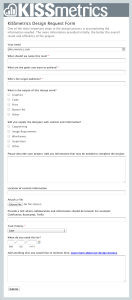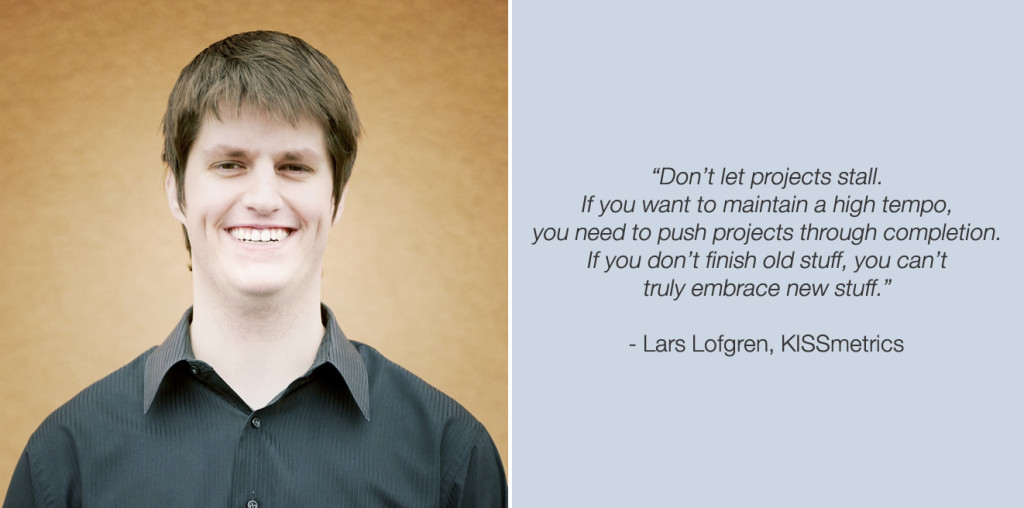
Welcome to our new series: How to Ship – we’ll be talking to leaders from some of the best teams in the world, so you can learn their secrets and apply them to your team.
This week we’re interviewing Lars Lofgren, the Growth Manager at KISSmetrics.
What does your company do?
KISSmetrics ties all your data to real people so you can find the best ways to optimize your growth. It’s an analytics tool for tracking the entire customer lifecycle so you can see exactly what your customers do, where they come from, and find insights for getting more of them.
Why did you choose Sprintly?
Our Design team uses Sprintly to track their weekly projects, it was their decision to try it out.
What’s your workflow for getting things done in Sprintly?
 I’m on the Marketing team so I mostly use Sprintly to coordinate projects with the Design team.
I’m on the Marketing team so I mostly use Sprintly to coordinate projects with the Design team.
We built a form in Wufoo that asks all the core questions that designers need to know for a project. Things like:
- What is the outcome and goals you want to achieve?
- Who is the audience?
- What are the deliverables?
Once a week, our Design team reviews all the submissions. Marketing also sends over a list of all open projects in order of priority. Then Design enters any new tasks into Sprintly and assigns them to designers. We then keep the conversation for that project in Sprintly so everything is in place. If someone has a question for me, they’ll just @ me and I’ll respond within the app. Helps keep everyone on the same page for where projects are at within the design cycle.
How do you decide and prioritize what you’re going to work on next?
My single goal at KISSmetrics is to drive growth. This means more signups, more leads, more opportunities for our Sales team, and more customers. I try to balance my priorities between projects that will drive growth immediately while laying the foundation for bigger projects that’ll grow KISSmetrics over the long term.
And of course, I’m constantly measuring everything to guide our priorities. We kill what’s not working, scale what is, and add a healthy dose of experiments to explore new areas.
How do you decide when something is done, and ready to be shipped?
Most of my projects start with a hypothesis. Then we ship when we’ve built to a point where can can confidently test that hypothesis. For projects that aren’t tests, we usually have a set of requirements. These aren’t nice-to-haves, they’re the bare minimum of what we need to solve whatever problem we’re tackling. We ship when we’ve gotten to that point.
In general, we try to err on the side of shipping too early. Yes, mistakes get made. But it also accelerates our feedback loop tremendously. We learn a lot faster and can respond to what truly works instead of sinking endless time into projects that never had a chance.

How do you involve your team in the development process?
Depends entirely on the project. If one of my projects will involve multiple teams (Marketing, Design, Engineering, Sales, etc), I’ll usually reach out to people on those teams beforehand and get their feedback on the project. Is this feasible? How much time are we talking? Is it even worth it? Then I’ll get it scoped out and start working with the key people that can help me ship.
We have a really awesome culture at KISSmetrics in that if you truly believe something is mission-critical, there aren’t many barriers to getting it done. You just have to take responsibility for it, lead the project, and convince others to help you when you need it. We have a few standard ways to get projects prioritized but much of it is ad-hoc. I love working directly with people on our team that are world-class in their domains. They always push projects to a much higher level than I could have expected.
What are some tricks you use to increase and maintain your velocity?
Don’t let projects stall. If you want to maintain a high tempo, you need to push projects through completion. If you don’t finish old stuff, you can’t truly embrace new stuff. You get burned out, your team gets burned out, everyone loses track of what’s important, and you drown in an endless list of priorities.
Be really clear with everyone what your priority list is. What is the next project that absolutely must get done? Then find the blocker and kill it. No one is going to drive your project except for you. So take ownership and ship it before getting distracted with something else. You’ll start making consistent progress that adds up a lot after a few months.
What are some obstacles you’ve had to overcome?
As any growing startup knows (not that we’re really a startup anymore, we’re over 50 employees at this point), to-do lists can get out of hand once your team starts to break into multiple teams. Projects come at you from a more people, priorities get mixed up, and people will start going in different directions unless you take the time to stay coordinated. A typical growing pain when a startup is no longer a startup.
We’ve spent the time to build a few processes so that teams can clearly communicate their main priorities to other teams. This way everyone knows what’s important and what they need to be focusing on.

How do you keep your team motivated to do great work?
Autonomy. We all have areas of responsibility that we own. I completely trust their decisions in those domains. And if I disagree, I’ll try to ask questions to get a better understanding of where they’re coming from. In most cases, I leave the decision to them. I’ll give my recommendation but it’s ultimately their call.
Also the commitment to always test new ideas. As long as the idea focuses on one of our main priorities and is somewhat feasible, we’re down to ship it and see what happens.
Big thanks to Lars Lofgren for sharing this behind-the-scenes look at KISSmetrics‘ shipping process.

